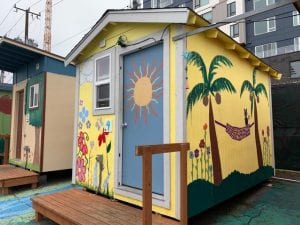
Artists and volunteers decorated the tiny houses in Seattle’s Lake Union Village, situated on a parking lot owned by the City of Seattle. Photo courtesy of LIHI
If you hang out with people who enjoy things like “clean eating,” yearlong getaways, and Marie Kondo coffee table books, there’s a pretty good chance you’ve stepped inside a tiny house.
Bear in mind, we’re not just talking about a “small” house here. Tiny houses, as most of us know them, are works of architectural whimsy that have taken up photographic residence in magazines like Conde Nast Traveler. They’re packed with features such as the shower-tub combo made from a wine barrel. Some tiny houses can be latched to the back of a vehicle and taken on the road, so if you work remotely (or if money isn’t something you think about) you could park your tiny house in the Grand Tetons for a week before dragging it over to Acadia.
The tiny house fantasy wasn’t really a thing until the aftermath of the 2007-2008 housing bubble explosion and the recession. Old school lifestyle “influencers” like Henry David Thoreau were early pioneers of leading simpler lives in tiny houses. But the notion that a tiny house could also be beautiful and innovative—an idea that emerged from the crater left by the recession—feels like a backlash to the grandiose real estate fantasies that once had Americans hot and bothered. We used to dream of spiral staircases, four-car garages, and waterfall-festooned pools that could be used for music videos or orgies. When the housing market tanked, we downsized our dreams.
Today, like many ideas that begin in upper-middle-class circles, the tiny house is being prescribed as something that all of society could benefit from. Tiny houses are often framed as an ecologically sustainable alternative to the traditional roomy house—just in time for the future era of mass displacement caused by climate change. But we don’t have to wait for sea level rises to imagine how the tiny house could be leveraged as a solution to our homelessness crisis. American cities are now building their own tiny houses to address that exact problem.
In recent history, the fix for homelessness in America has been shelter beds and, ideally, a case-manager–assisted segue to long-term housing. The trouble is that permanent housing for homeless people is in short supply. Many communities aren’t keen on building it, and those that want to build aren’t getting much support from the U.S. Department of Housing and Urban Development, which funds permanent housing projects. In search of a solution, more cities are tentatively embracing the tiny house in myriad ways.
Tiny Experiments
Last year, reporting for The Outline, I wrote about a tiny house experiment that took place here in Boston—where I and thousands of other residents are barely able to afford rent, and where the homeless have endured shelter closures and abuse from the Boston Police Department. The city, no doubt seeking better PR, joined forces with an architectural fellow at Harvard who had created a product known as the Plugin House: a simple build-it-yourself tiny house. What Boston wanted to do was persuade wealthy homeowners to build these houses in their backyards—ideally so that they could be used to accommodate either a homeless person or a low-income renter facing displacement. The city actually set up a prototype plugin house in Government Center plaza (a very busy stretch of Downtown Boston) so that passersby could experience them.
The idea didn’t germinate into policy. It was part of a pilot program in which Boston studied the efficacy of accessory dwelling units as a partial solution to its affordable housing shortage. But Los Angeles is taking this idea even further. The city has been trying to loosen zoning laws so that homeowners who want to make some money can build and rent their own ADUs—including backyard tiny houses. It also launched a pilot program in which homeowners are given a 10-year forgivable loan of up to $75,000 to build the ADU themselves and house a homeless person or a tenant who participates in the city’s housing choice voucher program (meaning they would pay 30 percent of whatever income they might have, and the landlord would receive the difference between that and fair market rent from the housing authority). If the ADU owner continues doing this for 10 years, the loan is forgiven. Meanwhile, in the Bay Area, for-profit startups like Rent The Backyard will supply eligible homeowners with a free tiny house in exchange for a portion of whatever monthly rent the homeowner collects from a tenant.
This is one way to do it—incentivize the comfortable to “share” a piece of their property with those who have no realistic pathway to permanent housing. (Though using the word share is a tad dodgy when you’re taking rent payments from a tenant.) Other cities, however, are sidestepping the whims of the individual homeowner and taking a more collectivist approach to building tiny houses for homeless people. Milwaukee, Denver, Sacramento, and San Jose are preparing to set up their own tiny house villages for the homeless—planned communities, funded and monitored by cities.
But Tiny Houses Won’t Fix Our Big Problem
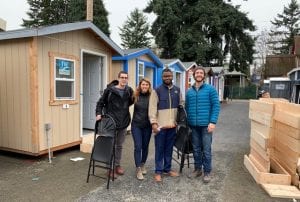
LIHI staff and volunteers at the Tacoma MLK Village, which opened on Dec. 19, 2019, on City of Tacoma property. It serves 35 homeless singles and couples. Courtesy of LIHI
One city in particular is already up and running with the idea. Seattle—home of Amazon, Starbucks, and one of the worst homelessness crises in America—has been building tiny house villages for the homeless with remarkable momentum. As of last March, the city had built 10 tiny house villages built on property owned by churches, nonprofits, and the government. Each one is funded by the Seattle nonprofit Low Income Housing Institute. The tiny houses are around 8×12 feet and are occupied by singles, couples, and even families. (According to LIHI, “A family of four can fit snugly in a tiny house.”) Some of the villages cater to specific demographics such as pregnant women, people of color, families with children, singles, or couples. Crucially, you don’t have to pay rent to live in one of these villages, which is a distinction that sets Seattle apart from other cities that are considering tiny houses as a workaround to building long-term housing.

San Jose Mayor Sam Liccardo visits a tiny house village in Seattle with LIHI executive director Sharon Lee, left, and Diana Salazar, director of Seattle’s homeless strategy and investment division. Photo courtesy of LIHI
There’s no time limit for how long somebody can live in one of Seattle’s tiny house villages. But according to LIHI executive director Sharon Lee, the average person’s village stay lasts about four to five months—during which time many are paired with a caseworker who tries to help them lock down permanent housing. The case workers actually work from within the village: the case management office is, itself, a tiny house. This, according to Lee, is one of the most integral pillars of Seattle’s villages. “[The case workers] work tirelessly,” Lee said. “They are so effective at getting people on housing waiting lists, Section 8 waiting lists, getting people IDs, employment, etc.” In 2018, 34 percent of Seattle’s tiny house dwellers were able to transition to permanent housing.
“Homeless people have to wait somewhere [for long-term housing] until their name comes up,” Lee says. “We [LIHI] own and manage 2,200 units of affordable housing, so we prioritize people who are living in the tiny houses into our own portfolio.”
Not all of Seattle’s tiny house villages were kickstarted by the city. One of them, Nickelsville, was actually created by homeless Seattleites themselves. Funding from LIHI helped residents of Nickelsville transform what began as a large tent encampment into a tiny-house village that was governed autonomously by the residents themselves—until recently. Earlier this year, a dispute arose between LIHI and Nickelsville. At the heart of this dispute was LIHI’s case worker provision. LIHI wanted Nickelsville residents to take more meetings with city case workers, to hasten their transition to permanent housing. This didn’t set well with many Nickelsville leaders, who felt that LIHI was trying to push them out of a community that they created for themselves. The talks fell apart. City workers were barred from entering Nickelsville. Shortly after, LIHI cut its subcontractor funding to Nickelsville.
The Nickelsville dispute brings to light many troubling questions about the efficacy of tiny houses as a solution for homelessness. But one of the most pressing is, why were Nickelsville leaders in opposition to the LIHI’s push for more meetings with case workers? According to a report from the Seattle Times, Nickelsville leadership felt that an uptick of case worker meetings would be futile because ”there isn’t enough affordable housing to make those meetings meaningful anyway.”
Let’s jump back to the stats for a minute. Last year, roughly one third of the people living in Seattle tiny house villages were able to find permanent housing. That leaves two thirds who weren’t. The city is investing in affordable housing development, but as we’ve seen in many cities across the nation, these projects are generally overshadowed by luxury development.
City leaders in Seattle and around the world see tiny houses as a bridge to a permanent housing. But how exactly do you build a bridge to something that doesn’t fully exist? And what implications does this have for the “bridge” communities themselves? The Nickelsville situation reminds us that tiny houses, while certainly a step up from shelter beds, are not meant for long-term occupancy. If you think of tiny houses as a simplified yet elegant response to the lavish and excessive houses that many used to dream of, living in a space no larger than a bedroom might seem fun—particularly if you’ve never had to deal with cramming your life into a 120-square-feet box. One of my fellow Boston residents, the writer Gene Tempest, experienced this while living in one of the “micro-apartments” that have been similarly framed as an affordable housing solution. The picture she painted wasn’t pretty.
“Even smell takes up space,” Tempest wrote in The New York Times. “We once made a meal that called for caramelizing three pounds of onions…. The eau de onion spread to everything. It clung especially to the moist bathroom towels and to the laundry drying in the bedroom. We were never clean again. Fresh from the shower, we immediately smelled of onions—of tiny house.”
The Tempest story, with its three pounds of caramelized onions, might seem a bit removed from the more elemental struggles of homelessness, but it nonetheless exemplifies one of the subtler ways in which tiny houses rapidly lose their luster. If you’re rich, tiny houses can be the equivalent of a juice cleanse. Going “small” can feel cleansing when you’re long accustomed to having more than what you need. And while tiny houses for the homeless certainly offer benefits that are preferable to shelter beds (a lock on the door, the feeling of privacy, pleasant colors, etc.) the fact that we’re not pairing them with expedited construction of housing that’s designed for long-term occupancy isn’t just a civic failure—it’s a civic regression.
Much as the modern tiny house village was preceded by sparser cabins of centuries past, the tiny house villages we’re seeing today are the descendants of Depression-era shanty towns that sprung up in American cities. Today’s villages may be regulated by the city and the residents may be supported by case workers, but what remains foundational to these villages—and the enthusiasm for them—is the consensus that right now, tiny houses are the best thing that we can do for homeless people. All of our aspirations to build housing for the homeless have failed to yield the housing stock that’s actually required to fix this problem. That’s because even today, decades after the Depression, America still doesn’t think of housing as a human right.
It’s likely that in the years ahead, the tiny house fad will start to wane, as soon as well-off people get bored and reacquaint themselves with the pleasures of more spacious living. And pending a major surge in affordable housing development, we’ll also start to see cracks in the tiny houses that cities are setting up for homeless people. That’s not to say that U.S. cities shouldn’t build tiny houses right now. As Lee put it to The Guardian in 2017, when Seattle’s tiny house villages were garnering press, “If the shelter can’t take [homeless people] where should they be?”
But in the same way that more homeless shelters didn’t change the game, more tiny houses can’t alleviate the homelessness crisis in a lasting way. So what will?
Resistance
By “resistance,” I don’t mean people in the street throwing bricks (though this could happen too, if housing crises get worse). I mean people pushing back against “out of the box” policy ideas that reflect the proclivities and comfort of the rich—ideas that distract us from the obvious solutions to problems like the homelessness epidemic. When policymakers tell us “we can’t just build more housing,” we need to interrogate that idea and ask, “Why?” Is it cumbersome zoning restrictions? Or is it the likelihood that building housing for everybody would be viewed as a redistribution of wealth and resources that are currently being hoarded by a minority of wealthy people? Is the prospect of having to share those resources the biggest obstacle to fixing homelessness?
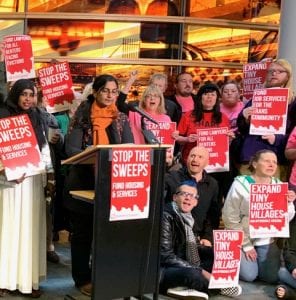
Seattle City Councilmember Kshama Sawant at a press event to expand tiny house villages. The Council voted unanimously in November to add $2 million to the mayor’s budget to expand more villages in 2020. Photo courtesy of LIHI
Consider Amazon—one of the wealthiest companies in the world, founded by a man who’s now one of the richest people on earth, and indisputably driving Seattle housing prices into the stratosphere. Amazon recently spent $1.5 million funding neoliberal candidates for Seattle’s City Council, in a nakedly obvious bid to drive out councilors like Kshama Sawant—councilors who’ve been supportive of not just the tiny house villages, but resurgent affordable housing development that would be subsidized by taxing Seattle’s wealthiest residents and corporations. But Amazon is also building its own homeless shelter, right in its downtown headquarters. Think about that for one minute. The most powerful and gluttonous company in Seattle won’t share its resources to build a wealth of permanent housing for the homeless (a drop in the bucket for Amazon). But it will allow homeless people to spend a couple of nights in its corporate office building. You almost have to wonder if the blankets, pillows, and cots will be provided and branded by Amazon Basics.
Now, compare Amazon’s shelter to what Seattle’s Low Income Housing Institute is working on—a new village that consists of not tiny houses, but cottages that are slated to open in 2020. Each of these cottages will have a living and sleeping area, kitchen, bathroom, totaling 384 square feet, plus a loft. The bedrooms are the same size as the entire tiny house interior dimensions. The cottages are meant for families and individuals with modest income. They’re an example of what the other side of the tiny house bridge could look like, if realized on a grand scale—if subsidized from new revenue raised from “corporate citizens” like Amazon. Alas, from city to city, what we keep hearing is “tiny houses! tiny houses!”—but we shouldn’t have to scale down the idea of basic economic security to fit inside the dimensions of a tiny house. And yet, that’s precisely what we’re doing.

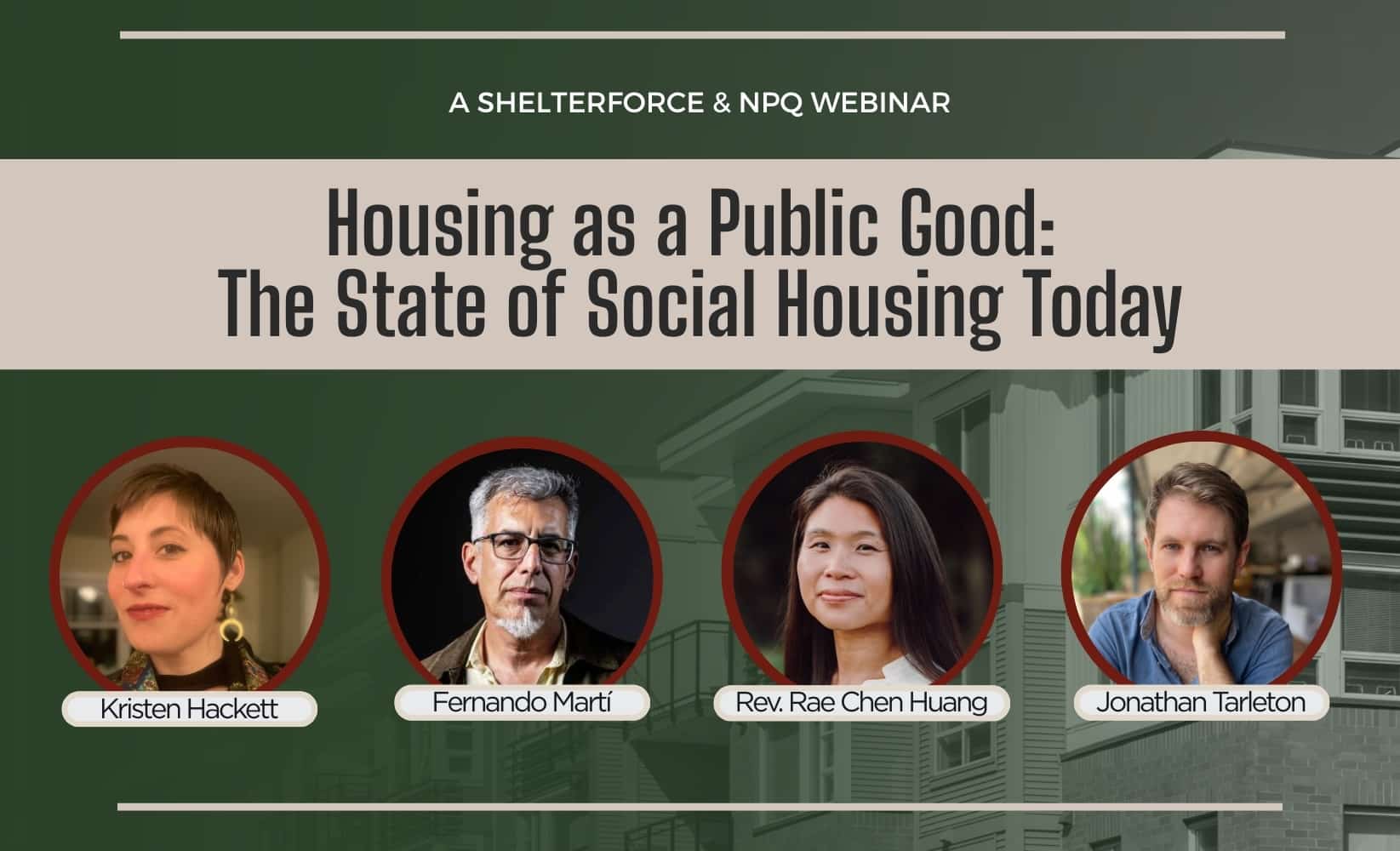

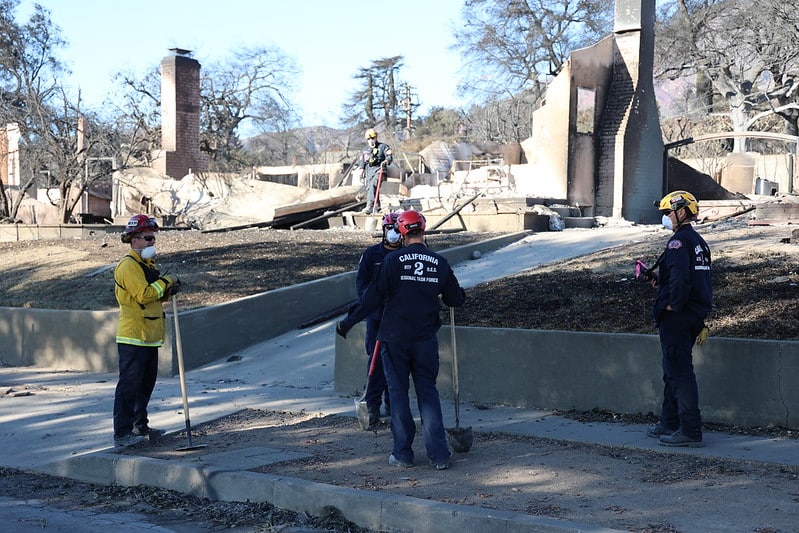
Do cities build tiny houses because other residents are so against density that they can’t build apartments? It’s not about the cost of the construction but the opposition to new density. If that’s the case it is a sad compromise. The city can build tiny houses but g-d forbid if the land was built as anything other than a detached dwelling.
ADUs are great. Is there a way to do them that doesn’t just reward those already wealthy enough to own a home. Maybe help a moderate-income family buy a house if some of the property is used for an ADU.
Our first apartment was a mother in law apartment that I believe was less than 400 sq feet. We paid $800 a month for it in the expensive Bay Area of California. Was it cramped? Yes. But it had a tiny kitchenette (no oven, just a stove, a sink and a microwave, plus maybe 2 cabinets — we bought a convenction oven), a small bathroom, a very skinny living room (more like a wide hallway from the bathroom to the bedroom, and a small bedroom that barely fit a bed and a dresser. We were incredibly happy to find a place we could afford. We ended up moving to a new city with more affordable prices and got a place 2x as big for less rent.
Sometimes, tiny places are needed to get one’s feet on the ground. And most of these tiny home villages are meant to be temporary. It seems like it would be nice if communities could build slightly larger pre-fab homes for people to transition to, where they also have to pay a share of the rent, depending on the income they are now making after the help they got from social workers at the tiny home village. This would help the government pay for these larger homes as people become more independent. And then, eventually, they could graduate out to places where they need less assistance, and they can keep progressing until they can buy their own home. (Depending, of course, on age, whether they have a disability, etc.)
Are you kidding me..a cottage of 384 sq feet? Some of the tiny homes are 500 sq feet and up. I suppose it depends on your definition of “tiny home”. We certainly need homes under 1,000 sq feet but let’s be realistic. Not everyone will want to live in a 500, 800 sq foot home. A single person would probably embrace these but not families.
Governments are very reluctant to get into the housing market in any form. Even the promise of incentives will not increase housing supply. It all comes down to making money and investment.
I am on the Affordable Housing Committee in South Burlington, Vermont, right next to Burlington. We are wrestling with these issues in the plural.
I suggest everyone reading Shelterforce find the Friday, January 31st stream on YouTube of the Harvard Joint Center for Housing 2020 report, broadcast from the Federal Reserve Bank in Minneapolis. Or read the report on their Harvard website. The panel discussion deals with many of these issues. One thing that everyone on the panel finally agreed upon was this: density drives building costs.
Density proponents won’t even discuss this fact. Constructing a 30 million dollar conglomerate building – and that is what the newest nonprofit multi-unit build proposed here will cost – does nothing to lower rents in itself. Here in Vermont as everywhere else, the single biggest cost factor is land prices. And they keep going up. Next is construction, because very few people want these jobs any more. Next is impact fees from local municipalities. The profit on affordable units starts at “0” and then goes into minus. The only way to recover costs is to raise the market rate units. That’s what we’re dealing with where I serve. ADU’s will not solve this problem, nor tiny houses either.
Tiny houses are just a modernized version of DIY housing security, they used to be called trailers. They are the safety net that people can reel out for themselves. The reason they have been championed by the middle class is because the middle class is squeezed and looking for affordable housing. The author doesn’t prefer to live in a small space, and his friend doesn’t know how to operate her onions, but this article won’t age well. Tiny Homes in all of their multiple formats will continue to be a welcomed housing option, and the legality and applications will only continue to grow over time. I have lived permanently in a tiny home for 6 years. The fact is the housing stock doesn’t match the residents, not everyone can afford to live in large homes and even some of us prefer not to. Physically we can, and advances in solar and battery technology in addition to future advances in pipeless toilets, and water generation will mean one can built or purchase their own housing security that can move with them and they will have many viable locations to settle these homes, in fluid and resiliant ways. for more information on how to be a part of this inevitable shift in housing options and learn real insights into teh potential of tiny homes, go to http://www.tinylogic.ninja
My guess is Adam K Garrett-Clark never lived outside, never slid under a dumpster to try to stay dry, never wrapped himself in paper to try to stay warm. “Go big or go home,” says Adam. “Every homeless person wants and needs a thousand square feet.”
Pshah!
For the last 24 years I have lived in a cottage attached to my barn – 760 square feet of indoor living space. Initially a financially driven decision but a now an unmitigated preference. I have a large walk in closet, a leather sofa bed for guests, a heart pine dining room table that sits eight 8, a 16 feet tall wall of books accessed by a custom ladder, and a 16 feet by 16 feet expanse of glass windows filled with a view of fields, forests, fences, all topped by the Blue Ridge Mountains.
I agree! I was thinking the same thing about the onion story: living in a tiny house requires adjustments ( ie don’t fry fish inside!). I agree that the housing supply needs to be addressed;
but just because emergency tiny housing for the homeless is considered traditional, doesn’t mean that tiny homes can’t also be a solution to the lack of supply of permanant housing. We could build slightly larger tiny houses ( 400-800 square feet). This would also put homeownership within reach of many Americans who would otherwise never have that chance. But we need to keep pushing for changes to zoning laws which keep obscenely sized and priced houses the norm.
I have been interested in tiny houses (which means they are on wheels and can be mobile) for years and I have never not one time seen a tiny house over 400′. I’ve only seen one that was that big. And it cost almost $250,000 to build. If someone is homeless and gets a tiny house where they are out of the weather and have a clean place to live and has a bathroom you would think that person would be grateful considering the alternative. To help the look for jobs knowing when they came home all of there things were there safe and sound is a far cry from how they were living on the streets. If your saying that they should not appreciate that your crazy. If you homeless is to good to live in them bring those houses to Delaware because our homeless would be very grateful to have them as a stepping stone to get their life back on track how ever long it takes. SMH.
Hi Why can’t we do what China did. I’ll bet every city has an abandoned mall no matter how big or small those malls redone the right way could become hundreds most likely thousands of small 1 & 2 bedroom apartment’s possibly 3 bedroom even. They would have a kitchen living room and bath room and storage area I’ve seen it done. The way it works is if you are waiting for your apartment to get done you must help do what’s needed what ever it is even if its sweeping the floors. The rule is everyone is assigned the same amount of rent for the same size unit. If you don’t have a job you are assigned a job to help with the upkeep of the grounds or inside cleaning the walkways or windows or apartments of the people who moved on to the next level. That way everyone gets an equal shot to move to the next level. Those that can’t pay rent and won’t do a job have to leave. I mean really this is about given people pride and dignity in theirselves. Just because a person is homeless doesn’t mean they don’t have a skill. This will allow them to work hard to be able to move on to the next level, so the next person on the waiting list can get started on their journey. These apartments would be for the homeless only no exceptions. Each mall would have it own team of overseers made up of 90% renters and 10 percent of the social works that were supposed to be finding permanent housing for the homeless. There’s all kind of things that could be done to make sure the property and units are kept up and safe. There could even be units for abused women and thier children since that’s another need that every city in every state has. The government and state would help subsidize it so the owners of the properties can make money too in stead of the mall seating empty. There are a lot of these malls sitting empty. The committee could get all kinds of people and organizations involved to bring the cost down of remodeling the malls. Like Habitate for humanity, Lows, Home Depot, Ace Hardware at the local level in stead of giving money that no one where it goes maybe the could donate products and volunteers. There are so many ideas that could make this happen. Why can’t we do something like that.
I absolutely agree Lynne. What we need is out of the box thinking. I’m sure there are naysayers who will give a thousand reasons why it can’t be done, but that’s why we have this crisis! The same old ‘solutions ‘ aren’t working. It’s time to try something new.
I do believe what is being done in Seattle is an answer. I lived in a tiny cottage built in 1947 and am a retired 70 year old. I would live in a tiny house in a new your minute. I loved every minute of it even after my daughter’s 5 person family moved in during covid. The house had some major repair issues so I was forced to leave as the landlord would do nothing. Most homeless are singles and doubles and with their lack of property can be very comfortable in such a setting. What a super way to get the homeless off the street and give them an address and a real chance. My dream is to live on a tiny house again but at the age of 70 with messed up credit that will most likely never happen. Thank you for your efforts.
I really appreciate the article, but wanted to mention a few things for consideration on the topic. I think the assumption about tiny homes being a fad is sort of jaded. I think a good contingency of the tiny home movement is rooted in a revival of Stoicism and Minimalism as ways of life. I think Tiny homes are in there essence a rejection of the non stop consumerism that generations are trained to accept from birth. I suppose the crux of my point is that cultural development is the root cause for the tiny home shift. People did Shanty towns in the wake of economic collapse that isn’t very comparable to modern times. Things like 08 Recession did leave a tough economic reality, but we have largely recovered since then, and yet the tiny home movement is growing everywhere that is under the influence of western society. I mentioned a revival of Stoicism and Minimalism, but I think its also connected to a collective understanding that the excessive lifestyles of our parents created a situation in which climate collapse was possible, so naturally people come to a conclusion that peace and prosperity are opposed to excess and consumerism. Just some last food for thought, most people lived in essentially “tiny” homes for most of human history, and in western civilization that changed when people started trying to pretend they were rich like the elites who owned their labor and that was what spawned the suburbs and excess spending.
In the end we as a society need to reach the point where we recognize permanent shelter as a human right. Hopefully we realize this before we all kill each other.
Great response. Really thoughtful ideas. Consumerism is killing us and our planet. Responsibility remains a dirty word, while Stoicism doesn’t get much traction with the luxurious crowd.
All I see being developed are luxury apartments, condos, and those who tear down middle class homes and build monstrous dwellings that occupies almost all their lots up to the property lines. Public housing stock is aging or has been torn down. Dilapidated, mid-20th century apartments are going for exorbitant rents or have been subdivided into tiny “bachelor studios” which even lack kitchens, let alone separate living and sleeping rooms and these are barely affordable.
America has lost her way and comeuppance for the wealthy is brewing and it won’t be pretty.
I am 65 very limited income my 2 kids are grown married with kids and lives of their own for over 30 years I was married worked and took care of my family my husband was a alcoholic and I finally left and divorced he spent all of our retirement money and savings and all I want now is my own place that I can afford and these houses are exactly what I need I don’t want to be a burden on my kids or anyone else and I know there are plenty other women just like me I’m physically challenged but would be able to care for this ( small kitchen area bathroom and a bed and tv) that’s all I want all in one room (bathroom-closed off) of course it would be easy to clean I don’t get around well and this small area would be perfect I don’t understand why people would deny or complain about someone just wanting their own place. As humans, soldiers, nurses, with our lives drastic changes that just happen and are out of our control we don’t need anything else and we need to get them to understand my mind is sharp I worked 40 years as a nurse my compassion is strong and true it’s just my money and my body just gave out on me
People just need someone to hold space for us and extend a hand to help us stand
Tiny houses are a solution for the homeless period. Those who think to the contrary need to get their heads examined. For starters, these homes are affordable. If build by volunteers, the cost factors on these homes are around $2/3/4/5k. Seattle has a good example of a tiny village with a communal room and social services offered on the spot. In turn, these homes are affordable for those living on fixed income and those who dont want 3/4/5 BR homes plus. I dont want to live personally in a mansion. Living in a tiny home with my partner is the way to go and I am living it as we speak. It is the best decision we have made! Both financially and retiring early. Thus, in conclusion, built these tiny homes for the homeless, for those on fixed incomes and those who want to down size from the consumer world of more, more, more garbage in your home. Enough is enough. Tiny homes are the answer for many of the nations and the worlds problem.